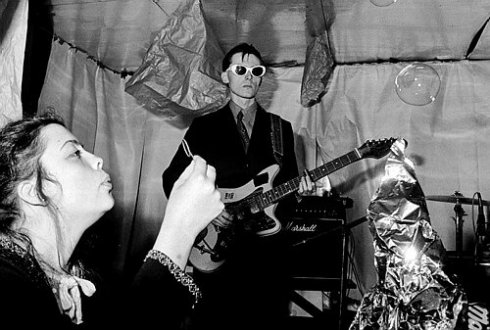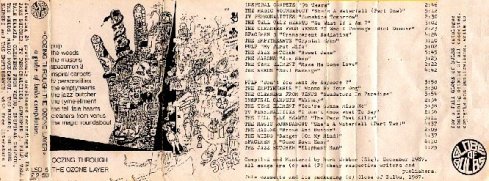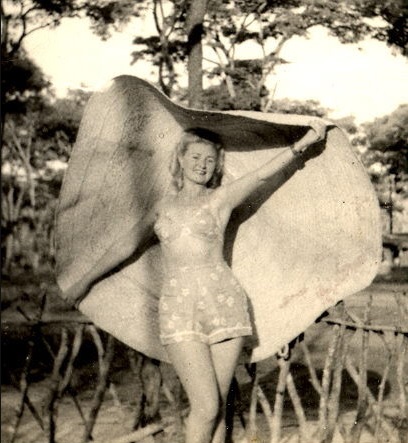
Steven Havenhand performing ‘And The Sun…’ and ‘Don’t You Want Me Anymore?’ (video)
And the Sun… at Pulpwiki
200% and Bloody Thirsty at Pulpwiki
The Day That Never Happened at Pulpwiki
We’ve had a few of these entries before, back at the other end of this decade, detailing missing songs which are un-recorded or at least not circulating. Happily, these dry up as the group starts recording more, and gigs are more frequently circulated. This is, then, the last of these summaries we’ll have to do until we get to the late 90s (and with a little luck the remaining ‘We Love Life’ demos will have been released by then) – and a bit of a measly one at that, containing a song that never made it, and another which might not really count. Interestingly enough, though, each tells us a little about two members – both bassists – who pass fleetingly through our story at this point.
The first of these is Steven Havenhand, who I’ve mentioned (briefly) before. Former singer with the legendary Lay Of The Land (who later became Warp Records, invented IDM, etc) and, perhaps as importantly, Russell’s sister’s boyfriend and later father to his nephew. Naturally, he was also a fan of the group – they’d been gigging regularly in Sheffield for six years by this point, and had a dedicated following among the otherwise slim pickings of the mid-80s scene.
1987 doesn’t seem to have been a particularly good time for Stephen to join. His previous group had fired him for “being disruptive” and he appears to have been in a pretty dark place generally. A talented musician in his own right, he nevertheless had a hard time fitting in with the group, largely due to his bass technique. It wasn’t that he as bad as such – just that he was too quiet, especially when the group were getting into their Slavic thrash and electro, and the low-key balladry of ‘She’s Dead’ was still a year away. Though he played on the FON demos of “Don’t You Want Me Anymore” “Rattlesnake” and “Death Comes To Town,” some studio trickery (and perhaps even re-recording) was needed for his parts. By the start of 1988 the probation period was over and it was clear things weren’t working out. Over a coffee at the Union bar, Jarvis told him he had to go.
In the last few years Steven has surfaced again as a singer-songwriter in Cornwall, working with The Friday Night Band. One of the most open and approachable of former members, he’s even helped out by uploading what he can remember of a song which didn’t make it out of rehearsals. A simple progression from A to A-minor, it features the lyrics “And the sun that continues to shine…” and sounds like a slower ballad – beyond this, there seems to be very little to say about it.
At times when Pulp is on hold, Jarvis tends to go off and work on other projects and collaborations. This time he spent a day in the studio with John Avery of Hula, writing and demoing a song called “200% and Bloody Thirsty” for a theatre performance of the same name. The song, described as “acoustic and raw” was not used in the final production, but it did receive one live performance at the most infamous Pulp concert of the 1980s, “The Day That Never Happened”
With the FON sessions showing no sign of being released, the membership still being in flux, and Jarvis weeks away from moving to London to start his degree course, Pulp were about to go into a couple of years of hibernation. What better way to mark this than by holding the most extravagant live event they’d ever attempted? Pulp concerts had always been as much about the visual as the auditory, and by this point the group were caught in a loop of trying to top their previous appearance every time, so much so that they may have been spending more time on set decorations than on practicing the actual music. Looking back now, it seems obvious that this level of ambition without funds or professional help to carry it out was bound to backfire at some point, but it must have been easy to get carried away at the time. Mark Webber later described the ensuing fiasco in an edition of Pulp fan club magazine ‘Disco-Very’:
The Day That Never Happened… featured the usual films, slides and tin-foil, along with a few trees (sprayed white), dry ice (home-made and very poor – it barely spilled over the saucer it was in), smells (Russell had made some charcoal incense, but of course the Leadmill is a big place so it didn’t carry too well), video projection (but the projector broke and we made do with a television on stage), and the most sensitive moment was to be a snow fall during a slow ballad … that ended up a total farce with people running around the stage carrying big hair-dryer things.
If the music had been up to scratch then this fiasco might’ve been charming, but this turned out to be equally problematic, partly due to problems with their new bass player, Anthony Genn. The younger brother of Steve Genn (who performed with Jarvis in ‘Heroes Of The Beach’ back in 1982), he was an outgoing, extroverted character, only aged 15 or 16 at the time. Like Magnus before, he was very much into the local psychedelics scene, and before long was declaring that “acid is the only reality.” Racking up debts of £760 and beginning to panic, he was pleasantly surprised one day to find a cheque for the exact amount needed on his doormat. Later that day a group came around from a Christian group
called The Nine O’Clock Service which turned out to be something like a cult. By the time The Day That Never Happened happened, Anthony had been persuaded to leave the secular world of Pulp behind, and had already announced his intention to quit. If he hadn’t, though, he might have found himself fired anyway. In ‘Truth & Beauty’ Nick described what happened next.
“We were all setting up, and I went ‘Anthony, tune your bass’ and he went ‘Yeah, yeah, I’ll get round to it.’ He was fannying around with something ridiculously unimportant. ‘Anthony, tune your bass.’ ‘Yeah, yeah.’….he was on stage and I could see him going ‘It’s out of tune!!’ Oh, for fuck’s sake… He had to have coloured stickers on the neck of the guitar to know where to go, it was that level of incompetence.”
Anthony spent the next few years in The Nine O’Clock Service before escaping its clutches and getting his life back on track. He was next spotted dancing naked on stage with Elastica during Glastonbury 1995, after which he actually joined the group on keyboards for a year or so. After helping Pulp with ‘additional programming’ on Different Class (whatever that means), he joined The Mescaleros, Joe Strummer’s backing band, and ended up co-writing and producing their first album. In the last decade he’s gone on to a fair amount of success with the band he formed with another ex-Mescalero, Martin Slattery,The Hours. Quite a life already, then, and he’s still only in his early 40s.
Two bass players down, then, and the great Pulp revival seemed to be stalled and rudderless. But appearances can be deceptive – one new bass player and the classic lineup and sound would be complete.
Tags: acoustic, fiasco, not a song, unreleased songs











